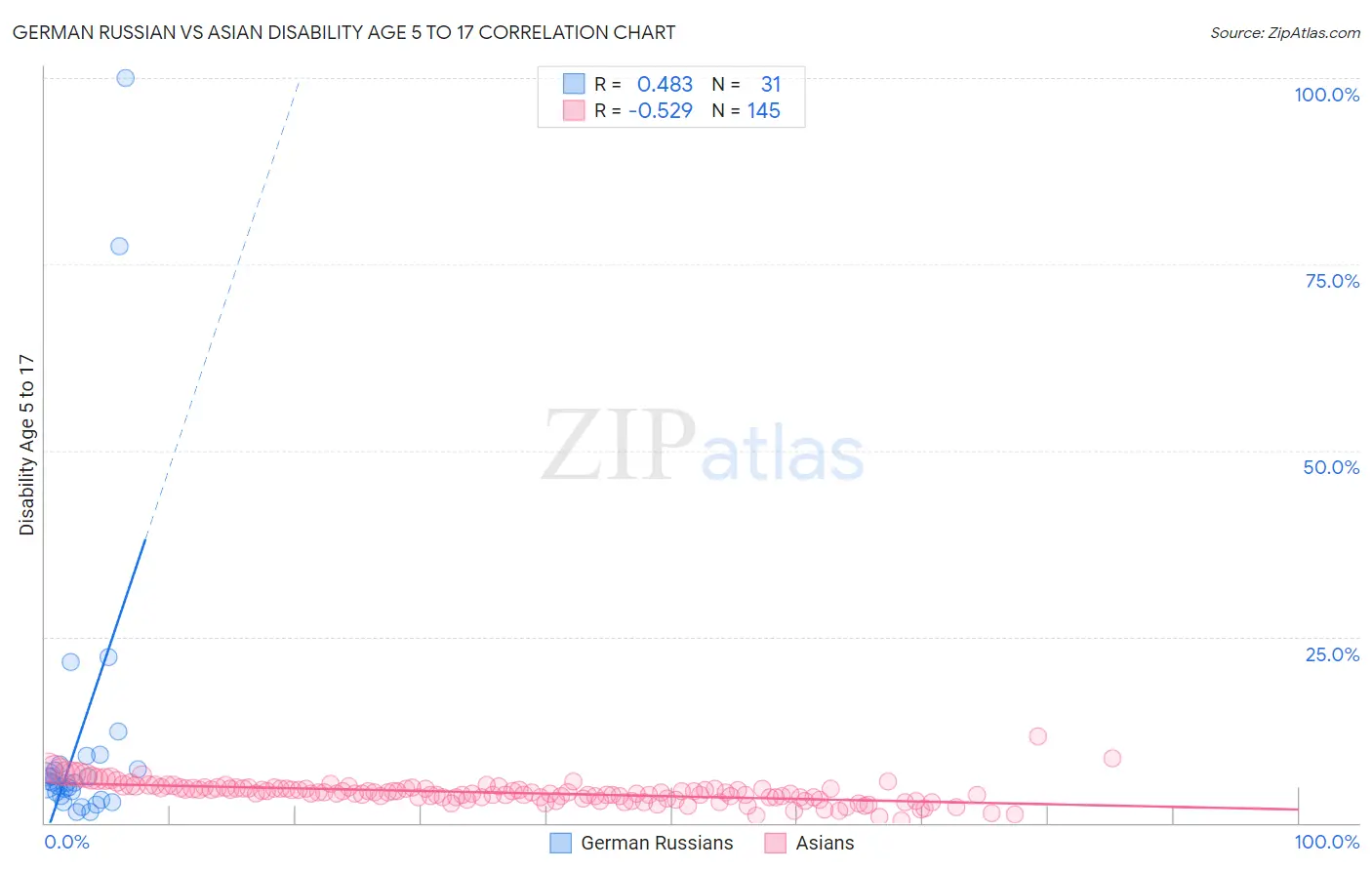German Russian vs Asian Disability Age 5 to 17
COMPARE
German Russian
Asian
Disability Age 5 to 17
Disability Age 5 to 17 Comparison
German Russians
Asians
5.9%
DISABILITY AGE 5 TO 17
2.4/ 100
METRIC RATING
239th/ 347
METRIC RANK
4.8%
DISABILITY AGE 5 TO 17
100.0/ 100
METRIC RATING
22nd/ 347
METRIC RANK
German Russian vs Asian Disability Age 5 to 17 Correlation Chart
The statistical analysis conducted on geographies consisting of 96,193,238 people shows a moderate positive correlation between the proportion of German Russians and percentage of population with a disability between the ages 5 and 17 in the United States with a correlation coefficient (R) of 0.483 and weighted average of 5.9%. Similarly, the statistical analysis conducted on geographies consisting of 540,712,205 people shows a substantial negative correlation between the proportion of Asians and percentage of population with a disability between the ages 5 and 17 in the United States with a correlation coefficient (R) of -0.529 and weighted average of 4.8%, a difference of 21.8%.

Disability Age 5 to 17 Correlation Summary
| Measurement | German Russian | Asian |
| Minimum | 1.4% | 0.35% |
| Maximum | 100.0% | 11.7% |
| Range | 98.6% | 11.3% |
| Mean | 11.7% | 4.1% |
| Median | 5.4% | 4.1% |
| Interquartile 25% (IQ1) | 3.6% | 3.4% |
| Interquartile 75% (IQ3) | 7.9% | 4.7% |
| Interquartile Range (IQR) | 4.3% | 1.3% |
| Standard Deviation (Sample) | 21.3% | 1.5% |
| Standard Deviation (Population) | 21.0% | 1.5% |
Similar Demographics by Disability Age 5 to 17
Demographics Similar to German Russians by Disability Age 5 to 17
In terms of disability age 5 to 17, the demographic groups most similar to German Russians are West Indian (5.9%, a difference of 0.020%), Hungarian (5.8%, a difference of 0.10%), Immigrants from Caribbean (5.9%, a difference of 0.15%), Sudanese (5.8%, a difference of 0.20%), and Spaniard (5.9%, a difference of 0.23%).
| Demographics | Rating | Rank | Disability Age 5 to 17 |
| Immigrants | Laos | 3.8 /100 | #232 | Tragic 5.8% |
| Immigrants | West Indies | 3.5 /100 | #233 | Tragic 5.8% |
| Immigrants | Kenya | 3.4 /100 | #234 | Tragic 5.8% |
| Malaysians | 3.4 /100 | #235 | Tragic 5.8% |
| Immigrants | Brazil | 3.2 /100 | #236 | Tragic 5.8% |
| Sudanese | 2.9 /100 | #237 | Tragic 5.8% |
| Hungarians | 2.6 /100 | #238 | Tragic 5.8% |
| German Russians | 2.4 /100 | #239 | Tragic 5.9% |
| West Indians | 2.4 /100 | #240 | Tragic 5.9% |
| Immigrants | Caribbean | 2.1 /100 | #241 | Tragic 5.9% |
| Spaniards | 2.0 /100 | #242 | Tragic 5.9% |
| Indonesians | 2.0 /100 | #243 | Tragic 5.9% |
| Immigrants | Germany | 1.9 /100 | #244 | Tragic 5.9% |
| Immigrants | Micronesia | 1.9 /100 | #245 | Tragic 5.9% |
| Tlingit-Haida | 1.9 /100 | #246 | Tragic 5.9% |
Demographics Similar to Asians by Disability Age 5 to 17
In terms of disability age 5 to 17, the demographic groups most similar to Asians are Yup'ik (4.8%, a difference of 0.34%), Burmese (4.8%, a difference of 0.56%), Immigrants from Bolivia (4.8%, a difference of 0.66%), Immigrants from Lebanon (4.8%, a difference of 0.81%), and Immigrants from Asia (4.8%, a difference of 0.92%).
| Demographics | Rating | Rank | Disability Age 5 to 17 |
| Chinese | 100.0 /100 | #15 | Exceptional 4.7% |
| Immigrants | Singapore | 100.0 /100 | #16 | Exceptional 4.7% |
| Arapaho | 100.0 /100 | #17 | Exceptional 4.7% |
| Immigrants | South Central Asia | 100.0 /100 | #18 | Exceptional 4.7% |
| Immigrants | Uzbekistan | 100.0 /100 | #19 | Exceptional 4.8% |
| Burmese | 100.0 /100 | #20 | Exceptional 4.8% |
| Yup'ik | 100.0 /100 | #21 | Exceptional 4.8% |
| Asians | 100.0 /100 | #22 | Exceptional 4.8% |
| Immigrants | Bolivia | 100.0 /100 | #23 | Exceptional 4.8% |
| Immigrants | Lebanon | 100.0 /100 | #24 | Exceptional 4.8% |
| Immigrants | Asia | 100.0 /100 | #25 | Exceptional 4.8% |
| Bhutanese | 100.0 /100 | #26 | Exceptional 4.9% |
| Taiwanese | 100.0 /100 | #27 | Exceptional 4.9% |
| Immigrants | Japan | 100.0 /100 | #28 | Exceptional 4.9% |
| Immigrants | Serbia | 100.0 /100 | #29 | Exceptional 4.9% |